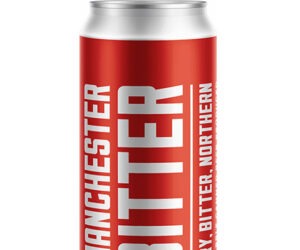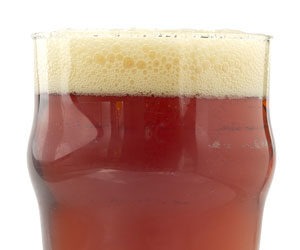A Bitter to Be Proud Of
A Bitter to Be Proud Of
(5 gallons/19 L, all-grain)
OG = 1.042 FG = 1.011
IBU = 35 SRM = 8 ABV = 4.1%
Ingredients
8 lbs. (3.65 kg) English pale ale malt
7 oz. (200 g) English crystal malt (75 °L)
5.5 AAU Target hops (60 min.) (0.5 oz./14 g at 11% alpha acids)
3.75 AAU Challenger hops (3 min.) (0.5 oz./14 g at 7.5% alpha acids)
4.25 AAU Northdown hops (3 min.) (0.5 oz./14 g at 8.5% alpha acids)
2.5 AAU East Kent Goldings hops (3 min.) (0.5 oz./14 g at 5% alpha acids)
Irish moss (15 min.)
White Labs WLP002 (English Ale) or Wyeast 1968 (London ESB Ale) yeast
1⁄3 cup corn sugar (if priming)
Step by Step
I use Crisp Malting’s British Pale Ale malt (made from Maris Otter) as my base grain, but other malts of a similar nature should work well. Remember, the bulk of the flavor comes from the base grain, so try to get British pale ale malt. The crystal malt should also be of British origin as it makes a substantial difference. I have had great success with Simpsons and Bairds, but feel free to substitute any high quality malt of a similar flavor and color from a different supplier. My hops are in pellet form and come from the UK via Hop Union or Hopsteiner.
Mill the grains and dough-in targeting a mash of around 1.5 quarts of water to 1 pound of grain (a liquor-to-grist ratio of about 3:1 by weight) and a temperature of 148 °F (64 °C). Hold the mash at 148 °F (64 °C) until enzymatic conversion is complete. Infuse the mash with near-boiling water while stirring or with a recirculating mash system raise the temperature to mash out at 168 °F (76 °C). Sparge slowly with 170 °F (77 °C) water, collecting wort until the pre-boil kettle volume is around 5.9 gallons (22.3 L) and the gravity is 1.035.
Add the bittering hops once the wort is boiling, The total wort boil time is 1 hour. During that time add the Irish moss or other kettle finings with 15 minutes left in the boil and add the last hop additions with 3 minutes remaining. Chill the wort to 68 °F (20 °C) and aerate thoroughly. If you have a nice, fresh package of liquid yeast, you can pitch it direct, although making a 1-liter starter is always a good idea.
Ferment around 68 °F (20 °C) until the yeast drops clear. With healthy yeast, fermentation should be complete in a week or less. Allow the lees to settle and the brew to mature without pressure for another two days after fermentation appears finished. Rack to a keg and force carbonate or rack to a bottling bucket, add priming sugar, and bottle. Target a carbonation level
of 1–2 volumes depending on your packaging. If you are cask conditioning the beer, add priming sugar, any cask finings (gelatin or isinglass), and possibly dry hop with another ¼–½ oz. (7–14 g) of whole East Kent Goldings. Allow the beer to condition in the cask for several days and serve via a beer engine or by gravity feed at 50–55 °F (10–13 °C).
A Bitter to Be Proud Of
(5 gallons/19 L, extract with grains)
OG = 1.042 FG = 1.011
IBU = 35 SRM = 9 ABV = 4.1%
Ingredients
5.4 lbs. (2.4 kg) English liquid malt extract
7 oz. (200 g) English crystal malt (75 °L)
5.5 AAU Target hops (60 min.) (0.5 oz./14 g at 11% alpha acids)
3.75 AAU Challenger hops (3 min.) (0.5 oz./14 g at 7.5% alpha acids)
4.25 AAU Northdown hops (3 min.) (0.5 oz./14 g at 8.5% alpha acids)
2.5 AAU East Kent Goldings hops (3 min.) (0.5 oz./14 g at 5% alpha acids)
Irish moss (15 min.)
White Labs WLP002 (English Ale) or Wyeast 1968 (London ESB Ale) yeast
1⁄3 cup corn sugar (if priming)
Step by Step
I use an English-type liquid malt extract custom made for my homebrew shop from a 100% Maris Otter malt. Both Muntons and Crisp offer a Maris Otter liquid malt extract as well. It is always best to choose the freshest extract that fits the beer style. The crystal malt should also be of British origin as it makes a substantial difference. I have had great success with Simpsons and Bairds, but feel free to substitute any high quality malt of a similar flavor and color from a different supplier. My hops are in pellet form and come from the UK via Hop Union or Hopsteiner.
Mill or coarsely crack the specialty malt and place loosely in a grain bag. Avoid packing the grains too tightly in the bag, using more bags if needed. Steep the bag in about 1 gallon (~4 liters) of water at roughly 170 °F (77 °C) for about 30 minutes. Lift the grain bag out of the steeping liquid and rinse with warm water. Allow the bags to drip into the kettle for a few minutes while you add the malt extract. Do not squeeze the bags. Add enough water to the steeping liquor and malt extract to make a pre-boil volume of 5.9 gallons (22.3 liters) and a gravity of 1.035. Stir thoroughly to help dissolve the extract and bring to a boil.
Once the wort is boiling, add the bittering hops. The total wort boil time is 1 hour after adding the bittering hops. During that time add the Irish moss or other kettle finings with 15 minutes left in the boil and the last hop additions with 3 minutes remaining. Chill the wort to 68 °F (20 °C) and aerate thoroughly. If you have a nice, fresh package of liquid yeast, you can pitch it direct, although making a 1-liter starter is always a good idea.
Ferment around 68 °F (20 °C) until the yeast drops clear. With healthy yeast, fermentation should be complete in a week or less. Allow the lees to settle and the brew to mature without pressure for another two days after fermentation appears finished. Rack to a keg and force carbonate or rack to a bottling bucket, add priming sugar, and bottle. Target a carbonation level of 1–2 volumes.
Written by Jamil Zainasheff

Jamil Zainasheff provides readers with an English Bitter that they can be proud of. Find ingredients and step by step here.


